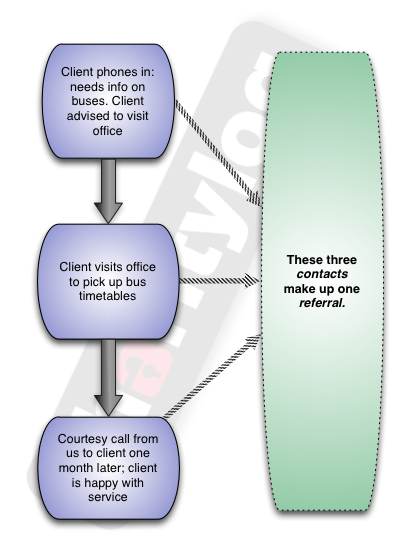Difference between revisions of "Template:Rac1overview"
m |
|||
| Line 6: | Line 6: | ||
This chapter will mainly focus on the work management side of recording contacts. The counting is being done in the background, and we'll look at it in the [[Reporting and Outcomes 1: Overview|Reports]] chapter. | This chapter will mainly focus on the work management side of recording contacts. The counting is being done in the background, and we'll look at it in the [[Reporting and Outcomes 1: Overview|Reports]] chapter. | ||
| + | |||
| + | ==The chain of actions== | ||
| + | |||
| + | So what exactly do we mean by "recording contacts"? Well, let's look at an example; imagine that your organisation helps people apply for benefits. This flow chart shows a (simplified!!) piece of work that might be done with a client that wants to access a certain benefit. If we were to describe the whole piece of work, we might say the following: | ||
| + | |||
| + | '''"Mrs Jones phoned in for information about this benefit. We decided she might be eligible and booked a time for her to come into the office. After speaking to her in person it seemed that there was a good chance of her obtaining the benefit. She took the relevant forms home, filled them in and returned them. We sent them to the relevant person at the Council, and after a few weeks, her benefit was awarded. We conducted a follow-up interview three months later and she was very happy with our service."''' | ||
| + | |||
| + | |||
| + | [[File:rac_overview_1.png|border]] | ||
| + | |||
| + | |||
Contents of this chapter: | Contents of this chapter: | ||
| Line 11: | Line 22: | ||
'''Recording Contacts 1: Overview (you are here)''' | '''Recording Contacts 1: Overview (you are here)''' | ||
| − | '''[[Recording Contacts 2: Finding and creating a client]] | + | '''[[Recording Contacts 2: Finding and creating a client]]''' |
| + | |||
| + | '''[[Recording Contacts 3: Contacts with clients]]''' | ||
| + | |||
| + | '''[[Recording Contacts 4: Contacts with anonymous clients]]''' | ||
| + | |||
| + | '''[[Recording Contacts 5: Contacts with other people]]''' | ||
Revision as of 11:02, 30 December 2012
Recording contacts is really what Charitylog is all about. We want to help you get the numbers and statistics you need for funders. Mainly, organisations need to count the interactions they have with their clients.
Simply making staff count their interactions is doomed to failure, because it's an extra job. That counting has to be done by someone, but it doesn't tend to work if you just ask staff to count things. With Charitylog, we give your organisation an extra bonus: a comprehensive way of managing your work, passing work from one person to another (no more emails, telephone messages or scraps of paper!) and recording case files.
This chapter will mainly focus on the work management side of recording contacts. The counting is being done in the background, and we'll look at it in the Reports chapter.
The chain of actions
So what exactly do we mean by "recording contacts"? Well, let's look at an example; imagine that your organisation helps people apply for benefits. This flow chart shows a (simplified!!) piece of work that might be done with a client that wants to access a certain benefit. If we were to describe the whole piece of work, we might say the following:
"Mrs Jones phoned in for information about this benefit. We decided she might be eligible and booked a time for her to come into the office. After speaking to her in person it seemed that there was a good chance of her obtaining the benefit. She took the relevant forms home, filled them in and returned them. We sent them to the relevant person at the Council, and after a few weeks, her benefit was awarded. We conducted a follow-up interview three months later and she was very happy with our service."
Contents of this chapter:
Recording Contacts 1: Overview (you are here)
Recording Contacts 2: Finding and creating a client
Recording Contacts 3: Contacts with clients
